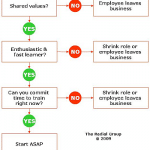Your corporate wellness business just closed a big deal. Your local newspaper just featured your diabetes fitness program. And yet…it feels like you’re overlooking something. It’s that feeling that despite success…failure could be lurking around the corner. That feeling is our brain’s way of telling us we’re missing something.
These questions will help highlight potential gotchas while you still have time to change the future:
1. Are you navigating, or just driving?
For fitness and wellness businesses, every day brings critical business decisions. Should you promote that great fitness manager in Austin to sales director for the region?Customers love her, but the skill set is different. Or should you continue leading the sales organization yourself, vetting every decision? Should you hire that web outfit to create a site for you, or keep doing it on the fly with a one-person development shop?
If you react in the moment — if you’re surprised that the decision is upon you — chances are you’ve been on auto-pilot too long. A sound business strategy requires thinking well in advance about the problems that might come along — before they get here. Focusing just on today’s issues is setting yourself up for trouble later. Growing businesses need to anticipate future issues to succeed.
2. Do you talk more about your past successes than your current plans?
Don’t get us wrong: sharing successes — especially if it’s your customers doing the talking — is a good thing. But after that glowing testimonial or that TV interview, it’s very tempting to focus only on What Your Business Did Right and forget that THOSE results came from a plan and actually represent the culmination of lots of hard work, over a long time, and probably involved a lot of different people.
What’s your plan going forward to increase brand recognition, reputation, and sales, or expand to other markets? Do you have one? Or are you just figuring that success will somehow magically bring more success?
3. Do you obsess about what you could have done differently?
OK, so at some point your tactics didn’t work. You lost a client, a sales opportunity, or screwed up with investors. That teaches you something about your strategy and how you executed it. It’s just a mistake, and it’s a learning moment. Go ahead and think about what you would do differently in similar situations in the future.
It’s important to pivot quickly from anxiety to action: figure out what happened, how and why it happened, and adjust your plans and priorities for next time. This is an area where inviting objective third parties to comment can be useful.
4. Does “unfamiliar territory” scare you?
Should you pay a company to develop a custom mobile app for your corporate wellness weight management program? Not sure if the diabetes outreach center at the hospital you’re thinking of partnering with is your ticket to the big time?
Make a list of all the possible outcomes — not just the good, and not just the bad; not just the likely, but the unlikely ones, too. Write them down on paper, and map out what you’ll do in each case. Play them out in your mind. Fore-informed is forearmed. And before you panic, remember: what is familiar now to you once wasn’t, and your wellness business survived and flourished.
5. Are you avoiding tough decisions just because they’re tough?
It’s important to face head-on questions about what your wellness business needs, and anticipate how you’ll meet those needs. Plan as if what’s half-a-mile ahead is already behind you.
For instance, if you’re thinking about “taking your business mobile,” ask yourself what that means and will happen once everything’s in place: what does it look like? Who and what does it affect? How does it work on a day to day basis? Who maintains it? Does it generate revenue or product interest, or is it just “cool?” Mobile-friendly email might turn out to be super-important; a mobile app, not so much unless your customers are tracking lifestyle changes. Will social build your wellness or fitness brand or just consume resources? It depends on what you do with it.
Time to look at your strategy, develop a plan, examine likely consequences, and act. Like “Google driving” a cycling or running route before you actually do it, it’s easier to travel the road ahead once you can picture it.



